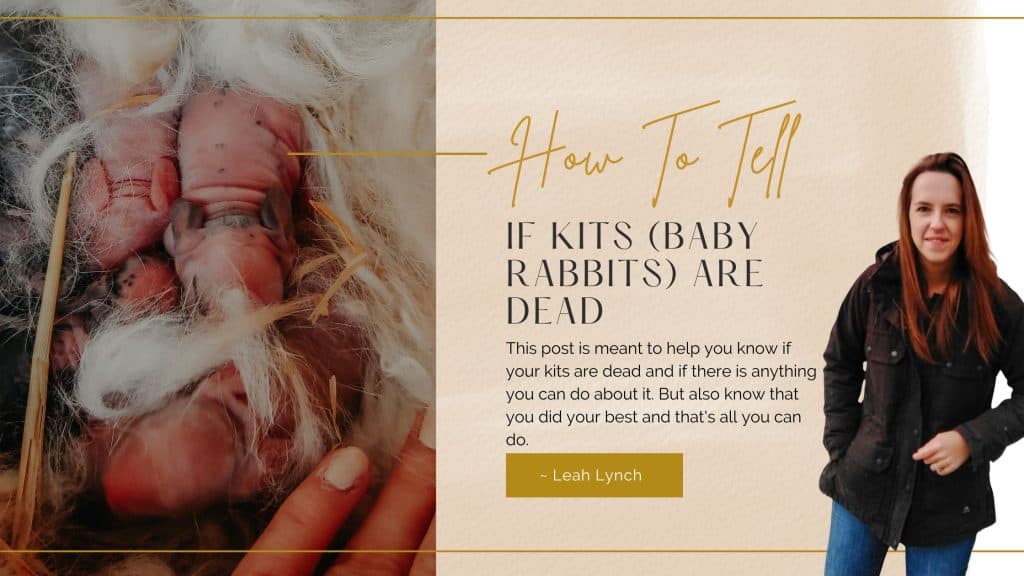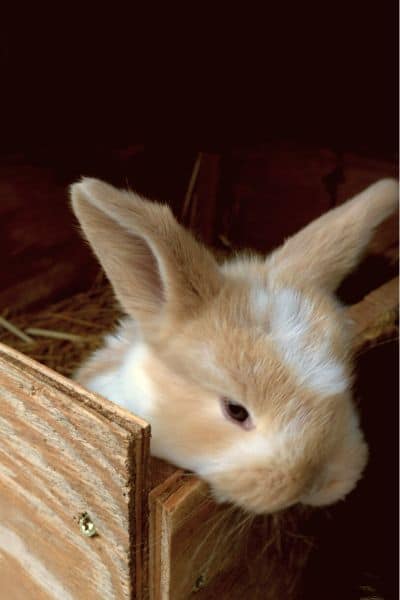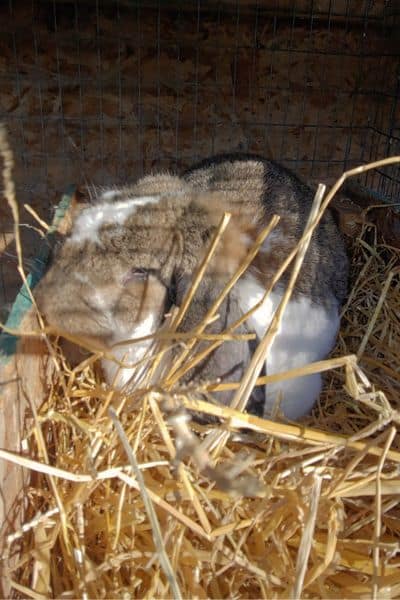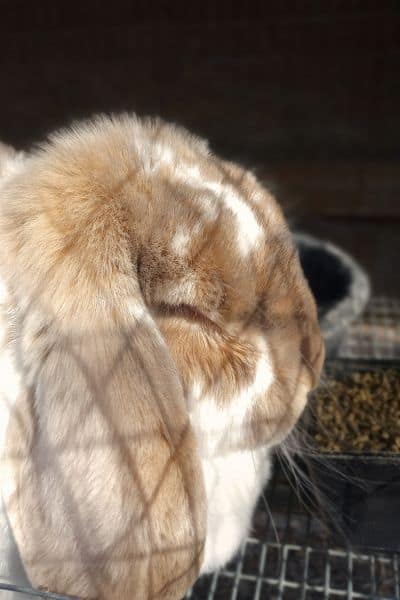How To Tell If Baby Rabbits Are Dead [What To Do About It]
Not sure how to tell if baby rabbits are dead?
If things went according to plan when raising rabbits they would be always born in a nest, out of the way of momma’s huge feet, and all warm and cozy…
Buuuut that has only happened MAYBE 25% of the time, especially with french lops. Newborn kits (baby rabbits) are extremely vulnerable, some breeds just do not raise litters well, and there is a lot going against them. Not to mention if your doe (momma rabbit) doesn’t like something about the location of the nest or a certain smell she might abandon her job altogether.
Why am I starting off the post sounding like a downer? I want you to understand that it’s not easy to begin with and if you are constantly having issues just know that it’s not you. Sometimes things just go wrong even though you did your best. — Having an intentional strategy for your backyard farm will help you know what you are working towards and help you stay focused when the going gets tough.
I am constantly moving babies putting them in the right spot or moving the nest out of the way of where momma tends to land when she jumps in the nesting box.
French lops (the breed I raise) are not great moms and it’s totally normal for me to lose 1/3 of the kits that are born each summer.
Alright, ready to get to it?
This post may contain affiliate links and if you choose to make a purchase through my links I may receive a commission at no extra cost to you.
How To Tell If Baby Rabbits Are Dead From Being Cold
This is just about the only thing you are going to be able to bring a rabbit back from. There are several other reasons a kit (baby rabbit) may die that I will explain later. But let’s cover this one first.

If the kit looks dead from being cold, it is possibly resuscitable (wow that’s a big word) the kit will feel cool and be stiff with the legs often sticking straight out.
If the kit is cold, limp, and with no movement whatsoever after a few minutes of trying to warm it up, then it’s too late to bring it back. You have to catch the cold babies within about 30 minutes of them getting cold or it’s too late.
BUT even if you think it is too late you might as well try to warm it up. Better to be safe than sorry.
Here are the best ways to warm a baby rabbit that looks dead.
Top Ways To Warm A Baby That Is Cold
- Use a hairdryer on low heat. – Hold the hairdryer 12-18 inches away. You don’t want to burn the rabbits. Holding them with your hand is also a good way to make sure you don’t overheat or burn them. Make sure to put the babies in a basket with a cloth in the bottom to help you contain them if they start wiggling you don’t want to drop them.
- Heating pad – This is a great way to try and warm them up
- You can also try immersing them in warm water. Obviously, make sure to keep their heads above the water and dry them off really well once they are active.
- Your own body – This is some people’s favorite method and if I had to.. well ok but I’m not a fan of having little wigglers in my bra.
DO NOT use a heat lamp like you use for chicks. These put off too much heat and you will cook the kit.
Once the kits feel warm to the touch (you may not get them 100% back to normal) but moving and mostly warm is good enough to put them back in the nest. Being with their siblings is what keeps them warm the best.
But if they are still cold to the touch you don’t want to put them back in the nest quite yet because the other kits may move away from them and not keep them warm.
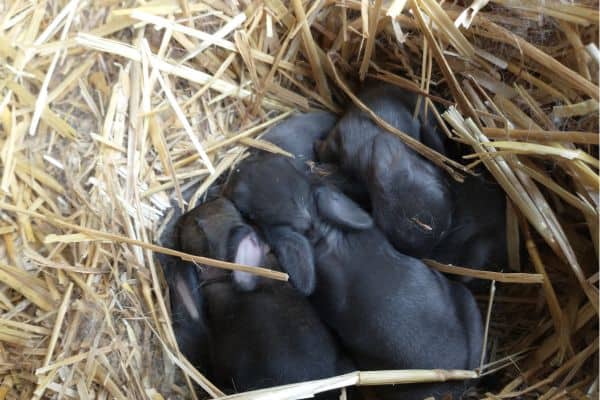
If you want to bring the whole nest inside to keep an eye on them for a bit you can do this too. Your doe (momma rabbit) only goes in the nest once or twice a day to feed them so keeping the baby rabbits for an hour or two won’t hurt anything.
There is also a method called shelving where you take the nests to a warmer place (most often on a shelf somewhere) and bring the nest box full of her own babies back to the mother rabbit twice a day. This often works if you have litters in the winter months. I try to avoid this because it’s a whole lot of work and gets old fast.
How Long Does It Take To Revive A Baby Rabbit?
If your kit (baby rabbit) is cold you should start to see movement in 5 minutes or less if there is going to be any chance of survival.
How To Know If The Kit Is Warm Enough to go back with the Litter
When I am warming up a kit I will often have it in a deep basket with rags in it. Then put the kit under a rag to keep it warm. Then I will put it in our smallest room with the space heater to get the room up to 75-80 degrees.
I want to be able to touch the kit without feeling a chill on its skin. If it can hold that for about 30 minutes without any type of heat source on it then I will put it back out with the rest of the litter.
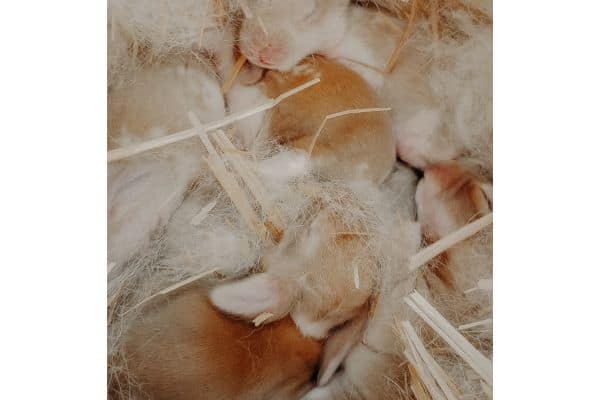
General Tips To Keep Kits Warm
- Mama’s fur is the most important thing to keep a litter warm. If your doe has not pulled fur you can often encourage her by plucking fur from her belly and dewlap (the double chin or the role of skin that is under her chin). The fur around those areas gets looser right around the time she has given birth so don’t feel bad thinking you are hurting her.
- Save Extra Fur For Later – If you have a doe that has pulled an excessive amount of fur then take some of that and put it in a bag. You can use that with a doe that has not pulled enough if necessary.
- 40 Degrees And UP – If the nighttime temperatures are below 40 degrees when the kits do not have fur I move them into our sunroom which is not as warm as the house but is better than fully being outside and they do great. Just make sure to take them back to Mamma as soon as you wake up. Don’t keep them away from her for more than 12 hours so she can feed them. Often times my girls are waiting by the cage door and are ready to jump in when they see the box coming.
How Cold Can They Handle
For newborn litters, if it is above 45 degrees at night they will be fine if they stay under the fur. BUT if they wander out of the nest they need to be found within 30 minutes or they will die.
If you have a decent-sized litter and they have fur but don’t have their eyes open they can handle just above freezing temps.
If it starts to get below 30 degrees I would bring them into a warmer area like a garage. But not as warm as your house, the change will be too much of a shock.
This is one reason why I am extra careful about the time of year my does are bred.
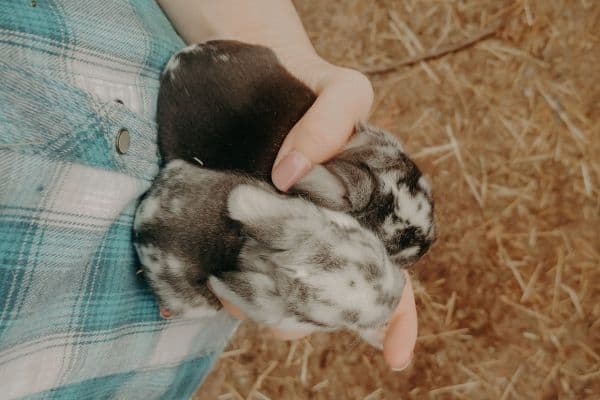
Will a momma rabbit remove a dead baby from the nest?
The short answer is no, you have to be the one to remove it from the nest box. It is unhealthy for the kits to leave that in the box and if it is mid-summer could lead to maggots being hatched out in the nest box. If you don’t want to touch it use a gardening hand trowl to scoop it out or a store bag to grab it out of the nest.
The rest of the kits may move to the other side of their nest box because the kit is cold and it is part of their survival instinct.
Another gross warning. Sometimes a doe may eat a dead kit for a number of different reasons. So be warned that can happen too. But all in all, it is best to just get the dead kit out of the box and keep the environment clean.
Free Farm Goal Planner!!!
➡️Get my proven system for choosing your farm goals so you don’t get burnt out.
What Does A Dead Rabbit Look Like
If the kit has just died it may be stiff. But if it has been gone for more than 12 hrs or so it might be floppy when you pick it up and somewhat flat. It depends on how it died as well. If momma stepped on it you could see some bruising if the kit is light colored.
Other Reasons Your Baby Rabbit Might Be Dead
Raising rabbits is not an easy thing. Momma rabbits don’t always do their job and things just go wrong.
- Baby rabbits might not be getting fed.
- The kit got stepped on.
- They wandered out of the nest and got cold.
- GRAPHIC WARNING ——————————- The doe ate all of or part of the kit. Yes, this happens more than I would like to admit. The reasons are just a guess. But often there is something wrong with the kit or the doe gets a screw loose. If your doe does it more than once I would not keep breeding her. It can be a bad habit you don’t want to pass on to feature generations.
How To Tell If Baby Rabbits Are Dead From Not Getting Fed
The kit will start to get wrinkles across the back like in the image below. The stomach will start to look flat and eventually, the kit will become extremely skinny.

It will take about 3 days before the baby will die. So this will leave you some warning and time to fix the problem. But it is best to help feed the kit if you think it is not getting fed rather than wait until the last minute. A kit as thin as above is not likely to make it even if it seems pretty mobile just because of shock and its already so far gone.
You should be able to hand-feed the kit so make sure to read this post if you think you are losing kits this way.
Get help and find motivation as we build our intentional backyard farm together.
Why Kits Don’t Get Fed
There are two main reasons that kits die of not getting fed. One is that there are just to many in the litter for the doe to feed and there could be some kits pushing the smaller ones out of the way.
Your Rabbit Is Not Getting The Nutriance They Need
This one is something I am seeing more and more and it ticks me off. Because it’s not your fault it’s the fault of the media and people who think they know what they are doing but don’t actually raise rabbits.
In short, your doe is not getting fed the right nutrition and she is starving. This whole agenda of feeding rabbits mostly hay and vegetables and little to no pellets is causing so much harm. I see people in my inbox all the time wondering what’s wrong and once they start feeding their rabbits better the problems turn around.
Vegetables have less than 3% protein and those nice green-looking bags of hay the store wants to sell you are often 9-12% protein if you are lucky.
Your rabbit MUST HAVE 16-18% protein to live!!!!!!!!!!!!
If you are pushing your rabbits to eat these lower percentage feeds they don’t have room for pellets with enough protein and they are ultimately starving. The doe can not provide the milk she needs to if she is not fed well herself.
You don’t have to feed the same brand but this is the feed tag from the rabbit pellets I feed. You can use this as a guide to look for feed that matches the similar nutrient.
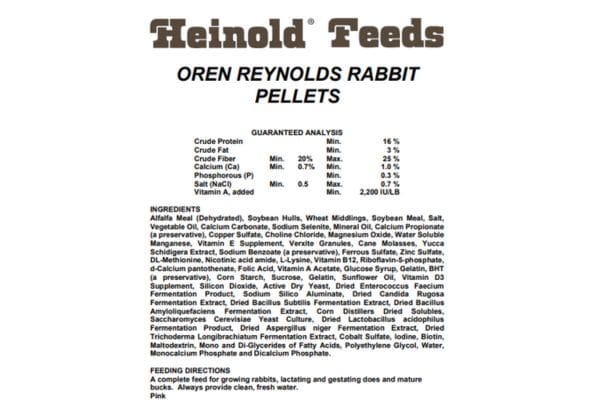

Why Do Rabbits Need Pellets To Be Healthy – Read the post.
How To Tell If Your Baby Rabbit Died From Getting Stepped On
I have big rabbits so this happens quite often.
If the kit has been stepped on it will often be outside the nest (the hole that the momma made but still inside the nesting box) and be soft and playable from below the ribs. You may even see some discoloration (blue/green in color) in the midsection indicating internal bleeding.
If you are having trouble with this read this post I have on what to do if your mother rabbit is stepping on her babies.

PSA: this is assuming you do not have a colony set up or have other rabbits with the mom and litter. I do not recommend having multiple rabbits together ever.
Will A Momma Rabbit Remove A Dead Kit
The short answer is no, a doe will not remove a dead kit from a nest. If one is missing or you can’t find one there are a few other possibilities so make sure to read this post that goes into nesting behavior and if a momma rabbit will remove a dead kit from the nest.
Losing rabbits sucks. Flat out. This can be a big reason I see people give up raising them. But do your best to not let your heart get attached until they are closer to 10-14 days old. Learning how to have enjoyment without attachment will be a huge help to you.
I know this can be hard and honestly, it takes years of experience and a lot of losses before you can keep going and not let it break your day to pieces. It’s all a part of starting your backyard farm intentionally and with a purpose.
It takes time to learn to protect your heart but it is so worth it. Nothing good comes without the hard parts.
